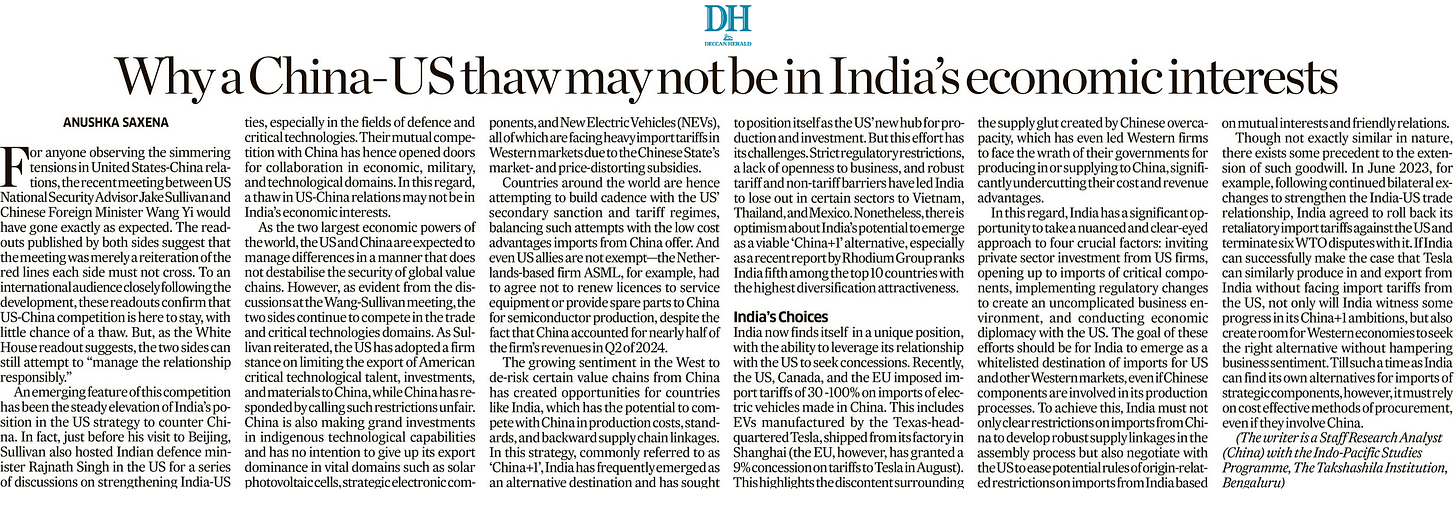That One There Was A Violation
Covering Chinese policy and rhetoric on external events and actors, military and security issues, economy and technology, and bilateral relations with India.
On August 26, 2024, the Japanese Ministry of Defence confirmed that between 11:29 and 11:31 AM local time, a Chinese surveillance aircraft violated Japan’s territorial airspace. In these two-to-three minutes, the Shaanxi Aircraft Company-made Y-9 (more specifically, its Y-9DZ variant), flew within the 12 nautical mile airspace of the Danjo islands, a small group of islands within Japanese territory in the East China Sea. Eventually, it headed out into international airspace. Due to the gravity of the violation, Tokyo responded firmly, by both scrambling fighter jets and lodging a formal protest with the Charge d’affaires of the Chinese embassy in Japan. Chinese officials have responded in a manner, with Foreign Minister Spokesperson Lin Jian stating that “Chinese military aircraft have no intention of intruding into the airspace of any country.”
It is true that in the past, a plane from the Chinese State Oceanic Administration Department and a drone from the Chinese Coast Guard, have breached Japanese airspace. It is also true that in recent times, People’s Liberation Army aircraft such as the Y-9 have conducted sorties around disputed territory in the East China Sea – namely, the Senkaku islands. However, because this is the first time a Chinese military aircraft has violated Japan’s airspace, there is intense deliberation surrounding the potential reasons for such a manoeuvre.
If the Y-9 was flown for just surveillance purposes, it likely hoped to gather intelligence on Japan’s radar systems, military bases and defence installations. There were speculations that it tried to survey the US Naval Base in Sasebo, located in the Nagasaki prefecture, as it provides logistical support to the US Seventh Fleet operations and is close to key areas in the East China Sea. But beyond the obvious, what could explain this rare violation? This blog discusses four such potential explanations.
Setting a New Normal
If the airspace violation was intentional, this might have been China attempting to create a “new normal” through its aggressive actions. By consistently pushing boundaries and engaging in provocative actions, China has been trying to shift the status quo. Routine conduction of grey-zone operations is a part of this strategy. Such operations aim to normalise Chinese assertiveness, making other countries more accustomed to such incursions, and testing their response capabilities over time. China has done so with Japan, South Korea, and Taiwan on a regular basis, deploying aircraft for sorties in their Air-Defence Identification Zones (ADIZ).
In this regard, such tactics act as a tool to garner attention to serve mainly two purposes: reinforce the narrative of China’s strength domestically and regionally, and demonstrate frustration due to recent developments. This may especially be true given the recent occurrence of the US-Japan 2+2 talks in July 2024, which culminated in an agreement on the possible use of nuclear force by US military personnel stationed in Japan. This is the crossing of a red line from the Chinese perspective, and could have motivated such an attention-seeking response.
A Tactic to Get Talking
China’s move, if intentional, could also be viewed as a way to pressure other nations into diplomatic negotiations. Through escalatory actions, China could be signalling an inclination to engage in talks and bring key issues to the table. Thus, while the primary intent might be to assert dominance or test boundaries, the willingness to enter discussions could also be part of a broader strategy to negotiate favourable outcomes.
But it is important to caveat this explanation with the reality of China-Japan relations. While it is true that the two countries have often clashed on the issue of sovereignty over Senkaku islands, high-level representatives from the two sides have been in talks twice over the past one year – once at a meeting between Xi Jinping and Fumio Kishida in November 2023, and the second time, during a trilateral between leaders from South Korea, China and Japan, in May 2024. Moreover, China acknowledges Japan’s sovereignty over the Danjo islands, and hence they are not disputed. And so, it may not make much sense from the Chinese perspective to get the two sides talking by flaring up a non-issue.
Diverting Negotiations
Some scholars have argued that such aggressive manoeuvres are deployed by China on a regular basis to divert attention from, or distract the participants and international audiences of a diplomatic event or negotiation about to occur. The event in question, in this case, could have been the meeting between US National Security Advisor Jake Sullivan and Chinese Foreign Minister Wang Yi, scheduled for August 27, 2024 in Beijing.
The goal of such a tactic is to divert from and undermine the prepared agenda. Hence, the tone of an otherwise diplomatic meeting becomes sour, and issues tabled for discussion are sidelined. This can be a harrowing experience especially for those making the trip out of their home countries to engage in negotiations. In this case, the target for such a tactic could have been the US NSA Sullivan, while the agenda items China attempted to sideline would also be issues the US lays great emphasis on – the domestic fentanyl crisis fuelled by Chinese exports of the drug, Beijing’s ban on movement of US nationals out the country, and its overall aggression and coercion in the Taiwan Strait and East and South China Seas.
However, it is important to note that the issue of the Y-9’s violation of Japanese airspace reportedly never came up during the Wang-Sullivan meeting. Moreover, if some logic, any at all, dictates the PLAAF’s sorties around Japan, the “spy balloon incident” of February 2023 should serve as a reminder of the drastic implications airspace violations can have for US-China relations.
A Mistake
In the context of China’s attempts to create a new normal by undertaking aggressive aerial manoeuvres around its neighbours’ airspaces, PLA personnel involved likely overshot their bounds in the heat of the moment. In this regard, one possible explanation of the airspace violation could just be that the Y-9 pilot made a mistake, and extended the mandate of the sortie unintentionally. While the potential data on electronic signatures collected during the violation could be of some use, the limited time period and high diplomatic costs of the violation make it unlikely that surveillance purposes alone could have motivated such a move.
In such a case, precedents dictate China is unlikely to issue an apology. But the statements from the MFA attempt to reflect that authorities are still deliberating internally, and never wanted the violation to occur. It cannot be said with certainty whether there was approval from higher ups for the pilots’ manoeuvres, however, the MFA has gone to great lengths to make it seem unintentional.
In all, it is plausible that one of the above-mentioned factors, or an interplay of some of them (such as the attempts to create a new normal leading to an unintentional mistake), explain the airspace violation by the PLAAF Y-9 (though the list may not be exhaustive nature). But if there was indeed a high-level sanction to such a manoeuvre, China not only failed in making it an issue during the meeting between Wang and Sullivan, but also failed in steering China-Japan talks in a positive direction.
Note: Cross-posted from the original source, the Takshashila Blog.
Latest from the Indo-Pacific Studies Team:
There is optimism in some quarters regarding India-China relations in the past few weeks, especially given that the Indian government’s July 2024 Economic Survey has expressed the need for being open to Chinese investment and technology, and to remain integrated with China-centered supply chains. And so, are India and China finally warming up to each other? In his piece for NDTV, Manoj Kewalramani takes a stance.
How would a thaw in US-China relations impact India’s interests? More specifically, what economic and regulatory opportunities and challenges has the West’s ‘China+1’ strategy created for India? In her piece for Deccan Herald, Anushka Saxena makes the case that US-China rapprochement may not be in India’s economic interests.

Concerns surrounding overcapacity in the Chinese industrial ecosystem are taking ground in Western economic thinking, and the potential supply glut has analysts and policymakers debating the way forward. India, too, has questions to consider. In the latest video episode of Takshashila’s daily public policy podcast, ‘All Things Policy’, Pranay Kotasthane and Anushka Saxena discuss the structural reasons for overcapacity in China, and a framework for India to assess its response.
Finally, on August 21, the 8th edition Ketagalan Forum, Taiwan’s high-level dialogue on Indo-Pacific Security, took place in Taipei. In another episode of ‘All Things Policy’, Amit Kumar quizzes Anushka Saxena on the developments at the Forum and the takeaways from the visions presented by Taiwanese, American, and Japanese representatives for cross-strait security. They also touch upon India-Taiwan relations and how the Wang Yi- Sullivan meeting panned out right after the Ketagalan engagements.








